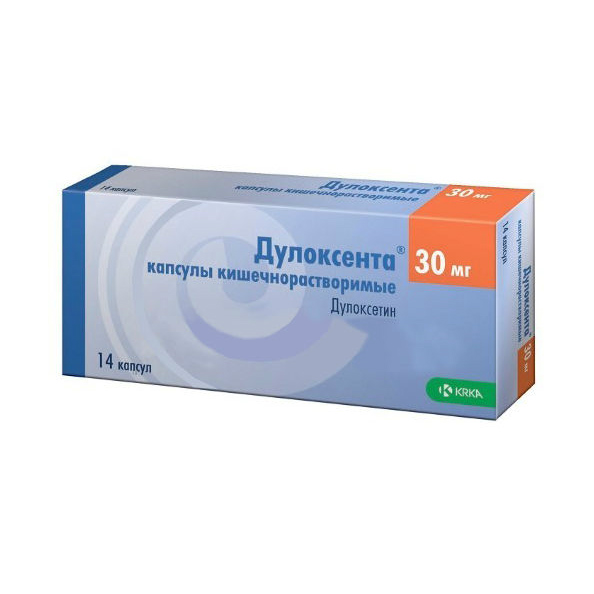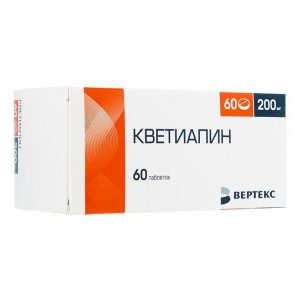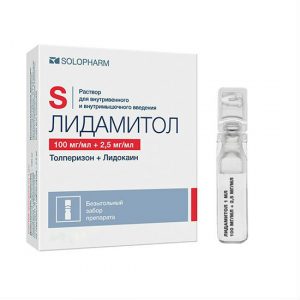Description
Pharmacological action
Pharmacotherapeutic group: Antidepressant
ATX:
N.06.AX21 Duloxetine
Pharmacodynamics: Duloxetine is an antidepressant, serotonin and noradine, noradine, noradine, norepine reuptake inhibitor, not having a significant affinity for histaminergic. dopaminergic, cholinergic and adrenergic receptors.
The mechanism of action of duloxetine in the treatment of depression is to suppress the reuptake of serotonin and norepinephrine, resulting in increased serotonergic and noradrenergic neurotransmission in the central nervous system (CNS).
Duloxetine has a central mechanism for suppressing pain, which is primarily manifested by an increase in the threshold of pain sensitivity in patients with a pain syndrome of neuropathic etiology.
Pharmacokinetics: Absorption
Duloxetine is well absorbed when taken orally. Absorption begins 2 hours after taking the drug. The maximum concentration (Cmax) of duloxetine is reached 6 hours after administration.
Eating does not affect Cmax of duloxetine, but increases the time to reach Cmax from 6 to 10 hours, which slightly reduces the degree of absorption (approximately 11%).
Distribution
The apparent volume of distribution is about 1640 liters. Duloxetine binds well to plasma proteins (> 90%), mainly to albumin and 1-acid glycoprotein, but liver or kidney disorders do not affect the degree of binding to plasma proteins.
Metabolism
Duloxetine is actively metabolized and its metabolites are mainly excreted by the kidneys. Both the CYP2D6 isoenzyme and the CYP1A2 isoenzyme catalyze the formation of two major metabolites (4-hydroxyduloxetine glucuronide, 5-hydroxy, 6-methoxyduloxetine sulfate).
Circulating metabolites do not have pharmacological activity.
Excretion
The half-life (T1 / 2) of duloxetine is 12 hours. The average clearance of duloxetine is 101 l / h.
Special patient groups
Gender
Despite the fact that differences in the pharmacokinetics of duloxetine in men and women have been identified (the average clearance of duloxetine is lower in women), these differences are not so large that there is a need for dose adjustment depending on gender.
Age
Despite the fact that differences in the pharmacokinetics of duloxetine in middle-aged and elderly patients were revealed (the area under the concentration-time curve (AUC) is longer and the duration of T1 / 2 of the drug is longer in elderly patients), these differences are not enough to change the dose in depending only on the age of the patient.
Impaired renal function
In patients with severe renal impairment (end-stage chronic renal failure) who are on hemodialysis, the values ² ¹ ² ¹of Cmax and mean exposure (AUC) of duloxetine increased by 2 times. In this regard, the feasibility of reducing the dose of duloxetine in patients with clinically severe renal impairment should be considered.
Impaired liver function
In patients with clinical signs of liver failure, a slowdown in metabolism and excretion of duloxetine may be observed. After a single dose of 20 mg of duloxetine in 6 patients with cirrhosis of the liver with moderate hepatic impairment (Child-Pugh class B), the duration of T1 / 2 of duloxetine was approximately 15% higher. than in healthy people of the appropriate gender and age with a five-fold increase in average exposure. Despite the fact that Cmax in patients with cirrhosis was the same as in healthy people, T1 / 2 was approximately 3 times longer.
Indications
– Depression
– a pain form of peripheral diabetic neuropathy
– generalized anxiety disorder
– chronic pain of the musculoskeletal system (including fibromyalgia, chronic pain in the lower osteoarthritis).
Contraindications
– Hypersensitivity to the drug
– concomitant use with monoamine oxidase inhibitors (see Special instructions)
– uncompensated angle-closure glaucoma
– childhood glucose dysrchosis, sarco-rtosis of children with 18 years -galactose malabsorption
– liver diseases accompanied by liver failure
– simultaneous administration of potent inhibitors of the isoenzyme CYP1A2 (fluvoxamine, ciprofl oxacin, enoxacin)
– severe chronic renal failure (creatinine clearance (CC) less than 30 ml / min)
– uncontrolled arterial hypertension.
Precautions:
Mania and bipolar disorder (including history), cramps (incl. history), intraocular hypertension or a risk of developing an acute attack of angle-closure glaucoma, suicidal thoughts and attempts in history, increased risk of hyponatremia (elderly patients, cirrhosis, dehydration, diuretics), impaired liver function and renal failure (QC 30 -60 ml / min).
Pregnancy and lactation
Pregnancy
Due to insufficient experience with duloxetine during pregnancy, Duloxent ® should be prescribed during pregnancy only if the potential benefit to the mother significantly exceeds the potential risk to the fetus. Patients should be warned that in case of pregnancy or planning pregnancy during treatment with Duloxetine, they need to inform their doctor.
Epidemiological evidence suggests that the use of selective serotonin reuptake inhibitors (SSRIs) during pregnancy, especially in the later stages, may increase the risk of persistent pulmonary hypertension in newborns. Despite the lack of research on the relationship of persistent pulmonary hypertension in newborns and the use of SSRIs, the potential risk cannot be excluded, given the mechanism of action of duloxetine (inhibition of serotonin reuptake).
As with the use of other serotonergic drugs, withdrawal syndrome can be observed in newborns in the case of the use of duloxetine by the mother in late pregnancy.
Withdrawal syndrome includes the following symptoms: decreased blood pressure, tremors, increased neuro-reflex irritability syndrome, feeding difficulties, respiratory distress syndrome, cramps. Most symptoms were observed during childbirth or in the first few days after birth.
Breastfeeding period
Due to the fact that duloxetine passes into breast milk (the concentration in the fetus is about 0.14% of the concentration in the mother based on mg / kg body weight), breastfeeding during therapy with Duloxent ® is not recommended.
Composition
Active ingredient: Duloxegine hydrochloride 33.675 mg, equivalent to Duloxetine 30,000 mg
Excipients: sugar grits, hypromellose 6cP, sucrose, hypromellose phthalate HP-50, talc, triethyl citrate.
Hard gelatin capsules No. 3
Shell: titanium dioxide (E171), gelatin
Lid: indigo carmine (E132), titanium dioxide (E171), gelatin.
Dosage and Administration
Inside. Capsules should be swallowed whole without chewing or crushing.
Do not add Duloxent ® to food or mix it with liquids, as this may damage the enteric coating of the pellets.
Depression
The initial and recommended maintenance dose is 60 mg 1 time per day, regardless of the meal time. In clinical studies, safety assessments of doses of 60 mg to a maximum dose of 120 mg per day were performed. However, no clinical evidence was found that patients who did not respond to the initial recommended dose showed any improvement with increasing dose.
Response to therapy is usually noted 2-4 weeks after the start of treatment.
In order to avoid relapse after reaching the response to antidepressant therapy, it is recommended to continue treatment for several months. In patients responding positively to duloxetine therapy, with recurring cases of history of depression, further long-term therapy is possible at a dose of 60 mg to 120 mg / day.
Generalized Anxiety Disorder
The recommended starting dose for patients with generalized anxiety disorder is 30 mg per day, regardless of the meal time. In patients with an insufficient response to therapy, it is possible to increase the dose to 60 mg, the usual maintenance dose in most patients.
In patients with concomitant depression, the initial and maintenance dose is 60 mg per day (see also recommendations above). During clinical trials, the efficacy of doses up to 120 mg / day was shown, in addition, such dosages were evaluated from a safety point of view. Therefore, in patients with an insufficient response to a dose of 60 mg, it may be appropriate to increase the dose to 90 mg or 120 mg. Dose increases should be based on clinical response and tolerance.
In order to avoid relapse after reaching a response to therapy, it is recommended to continue treatment for several months.
A painful form of peripheral diabetic neuropathy
The initial and recommended maintenance dose is 60 mg 1 time per day, regardless of the meal time. During clinical trials, safety assessments of doses of 60 mg to a maximum dose of 120 mg / day, divided into equal doses, were also performed. The concentration of duloxetine in blood plasma is characterized by significant individual variability. Therefore, in some patients with an insufficient response to a dose of 60 mg / day, improvements may be observed with a higher dose.
Assessment of response to therapy should be carried out after 2 months. In patients with insufficient initial response, an improvement in response after this period of time is unlikely.
The therapeutic effect should be evaluated regularly (at least once every 3 months).
Chronic pain of the musculoskeletal system (including that caused by fibromyalgia, chronic pain in the lower back and with osteoarthritis of the knee)
Initial treatment: the recommended dose of Duloxent ® is 60 mg once a day. Therapy can be started with a dose of 30 mg for 1 week, to allow patients to adapt to the drug before increasing the dose to 60 mg 1 time per day.
There is no evidence that higher doses provide an added benefit, even in patients who do not respond to 60 mg drug therapy. Higher doses are associated with a high incidence of adverse reactions.
Continued treatment: The effectiveness of duloxetine in the treatment of fibromyalgia has been demonstrated in placebo-controlled studies lasting up to 3 months. Effectiveness has not been established in longer trials, however, the decision to continue treatment should be based on the individual patient response.
Impaired renal function
With a CC of 30-80 ml / min, dose adjustment is not required, with a CC of less than 30 ml / min, the use of Duloxent ® is contraindicated.
Impaired liver function
Duloxent ® should not be prescribed to patients with liver diseases that lead to liver failure.
Age
Older patients for the treatment of generalized anxiety disorder are recommended an initial dose of 30 mg for 2 weeks before starting to use duloxetine in a target dose of 60 mg. In the future, it is possible to use the drug in a dose of over 60 mg per day to achieve a good result. A systematic assessment of taking the drug in a dose of over 120 mg was not carried out. When using duloxetine for other indications, dose adjustment depending on the age of the patient is not required. Is it recommended to use the drug in patients 18 years. Duloxetine is not recommended for children <18 years of age, due to the lack of data on its safety and effectiveness when used in this age group of patients. Cancellation of therapy Abrupt withdrawal of therapy should be avoided. Upon termination of treatment with duloxetine, the dose should be gradually reduced over 1-2 weeks in order to reduce the risk of withdrawal syndrome. If pronounced withdrawal symptoms occur after a dose reduction or after discontinuation of treatment, then continued administration of the previously prescribed dose may be considered. Subsequently, the doctor may continue to reduce the dose, but even more gradually. Drug Interactions Monoamine Oxidase Inhibitors (MAOIs) Due to the risk of developing serotonin syndrome, duloxetine should not be used in combination with MAOIs, and for at least 14 days after discontinuation of MAOI treatment. Based on the duration of T1 / 2 of duloxetine, a break should be taken at least 5 days after taking duloxetine before taking IMAO. For selective reversible MAOIs such as moclobemide, the risk of developing serotonin syndrome is lower. However, the simultaneous use of reversible MAOIs and duloxetine is not recommended. Inhibitors of the CYP1A2 isoenzyme Due to the fact that the isoenzyme CYP1A2 is involved in the metabolism of duloxetine, simultaneous administration of duloxetine with potential inhibitors of the isoenzyme CYP1A2 is likely to increase the concentration of duloxetine. A powerful inhibitor of the CYP1A2 isoenzyme fluvoxamine (100 mg once a day) reduced the average plasma clearance of duloxetine by approximately 77%. Caution should be exercised when using duloxetine with inhibitors of the CYP1A2 isoenzyme (for example, some quinolone antibiotics) and lower doses of duloxetine should be used. drugs, affecting the central nervous system Caution should be exercised when using duloxetine simultaneously with other drugs and agents that affect the central nervous system, especially those that have a similar mechanism of action, including ethanol. The simultaneous use with other drugs with a serotonergic effect (for example, SSRIs, SSRIs, triptans and tramadol) can lead to the development of serotonin syndrome. Serotonin syndrome In rare cases, with the simultaneous use of SSRIs (eg, paroxetine, fluoxetine) and serotonergic drugs, serotonin syndrome has been observed. Caution must be exercised when using duloxetine concurrently with serotonergic antidepressants, such as SSRIs, tricyclic antidepressants (clomipramine or amitriptyline), Hypericum perforatum, venlafaxine or triptans, tramadol, pethidine and tryptophan. Drugs metabolized by the CYP1A2 isoenzyme The simultaneous use of duloxetine (60 mg 2 times a day) did not significantly affect the pharmacokinetics of geophylline metabolized by the CYP1A2 isoenzyme. Duloxetine is unlikely to have a clinically significant effect on the metabolism of substrates of the CYP1A2 isoenzyme. Drugs metabolized by the CYP2D6 isoenzyme Duloxetine is a mild inhibitor of the CYP2D6 isoenzyme. When taking duloxetine at a dose of 60 mg 2 times a day simultaneously with a single dose of desipramine, a substrate of the isoenzyme CYP2D6, AUC of desipramine increases 3 times. The simultaneous administration of duloxetine (40 mg 2 times a day) increased the equilibrium concentration of tolterodine (2 mg 2 times a day) by 71%, but did not affect the pharmacokinetics of 5-hydroxymetabolite. Thus, caution should be exercised when using duloxetine with drugs that are mainly metabolized by the CYP2D6 isoenzyme and have a narrow therapeutic index. Inhibitors of the CYP2D6 isoenzyme Since the CYP2D6 isoenzyme is involved in the metabolism of duloxetine, the simultaneous use of duloxetine with potential inhibitors of the CYP2D6 isoenzyme can lead to an increase in the concentration of duloxetine. Paroxetine (20 mg once daily) reduced the average clearance of duloxetine by approximately 37%. Caution should be exercised when using duloxetine with inhibitors of the CYP2D6 isoenzyme (e.g., SSRIs). Oral contraceptives and other steroid drugs In vitro studies indicate that duloxetine does not induce the catalytic activity of the CYP3A isoenzyme. Specific studies of drug interactions in vivo have not been conducted. Anticoagulants and antithrombotic drugs Due to the potential increased risk of bleeding associated with pharmacodynamic interaction, caution should be exercised while using duloxetine and anticoagulants or antithrombotic drugs. In addition, with the simultaneous use of duloxetine and warfarin, the value of the international normalized ratio (INR) increased. Nevertheless, the simultaneous use of duloxetine and warfarin in stable conditions in healthy volunteers within the framework of a clinical pharmacological study did not reveal a clinically significant change in the INR from the average or pharmacokinetics of the right- or levorotatory isomer of warfarin. Antacids and antagonists of H2 histamine receptors The simultaneous use of duloxetine and aluminum and magnesium-containing antacids or duloxetine and famotidine did not significantly affect the degree of absorption of duloxetine at a dose of 40 mg. Inducers of the CYP1A2 isoenzyme Population pharmacokinetic analysis showed that plasma concentration of duloxetine is almost 50% lower in comparison with non-smokers. Drugs highly binding to blood proteins Duloxetine is highly bound to plasma proteins (> 90%). Therefore, the use of duloxetine in a patient who takes another drug that binds to plasma proteins to a high degree can lead to an increase in the concentration of free fractions of both drugs.
Overdose
There are known cases of overdose in clinical trials with simultaneous ingestion of up to 3000 mg of duloxetine, either alone or in combination with other drugs. However, one of these cases was fatal. However, spontaneous (post-marketing) messages contained descriptions of lethal acute overdoses, usually with the combined use of several drugs in which the dose of duloxetine was no more than 1000 mg.
Symptoms
An overdose of duloxetine (isolated or combined) may be accompanied by the following symptoms: drowsiness, coma, clonic convulsions, serotonin syndrome, vomiting, and tachycardia. In preclinical studies (in animals), the main signs of intoxication associated with an overdose related to disorders of the central nervous and digestive systems and included manifestations such as tremor, clonic convulsions, ataxia, vomiting, and decreased appetite.
Treatment
A specific antidote is not known, but in the case of the development of serotonin syndrome, correctional treatment with cyproheptadine and the use of methods to normalize body temperature are possible. Adequate fresh air should be provided. It is recommended to monitor cardiac activity and monitor key vital signs, along with symptomatic and supportive treatment. Gastric lavage can be indicated if there has been little time since taking the drug inside, or as part of a symptomatic treatment. In order to limit absorption, activated carbon may be used. Duloxetine is characterized by a large volume of distribution, and therefore the effectiveness of forced diuresis, hemoperfusion, metabolic perfusion is doubtful.
Storage conditions
At a temperature not exceeding 25 ° C, in the original packaging.
Keep out of the reach of children.
Expiration
2 years.
Deystvuyuschee substances
duloxetine
pharmacy terms for
Form of Treatment
kapsul




